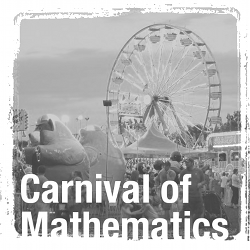Welcome to the 188th Carnival of Mathematics!

I believe it’s traditional to start with some facts about the number of the carnival, but why do that when I can let you discover them for yourself? Move the slider in the applet below and watch how the graph of the paramteric equations changes. What, if anything, does the shape of the graph tell you about the common factors of 188 and the selected number?
You can download the GeoGebra file from here if you so desire.
Now onto the good stuff!
In Quanta magazine, Joshua Sokol describes research by Gábor Domokos and Douglas Jerolmack that tells us that, on average, the world is made out of cubes. The article includes what might be my favourite quote from the month: ‘About 50 years ago, the Russian nuclear physicist, dissident and Nobel Peace Prize winner Andrei Dmitrievich Sakharov posed the same problem while chopping heads of cabbage with his wife. How many vertices should the cabbage pieces have, on average?’
Also in Quanta, Kevin Hartnett tells us about a secret society of mathematicians who write ‘books intended as pure expressions of mathematical thought’.
Kaneenika Sinha and @IWTKquiz have produced a fascinating Twitter thread highlighting the work of Indian women in mathematics.
Adam Atkinson has been investigating the use, or otherwise, of mixed numbers in Italy and other countries. Adam says ‘Many people in mixed and unmixed countries have no idea the other kind of country even exists. People ask me both “Are there really places where this notation is used?” and “Are there really places where this notation is not used?”.’
If you’re in a philosophical mood, you might like this short essay about the moral implications of ‘proof’, from Kartik.
Paul O’Malley told me of a video about using mathematical tools to deblur images. The video is part of the Talk Math With Your Friends (TMWYF) series, which is a weekly online mathematics colloquium. There is an archive of all their previous talks, and you can find details of what’s coming up by using the #TMWYF hashtag on Twitter.
You might already know how to test for divisibility by 2, 9 and maybe even 11. Now Mark Dominus tells us how to test for divisibility by 19.
The weekend of 21st-22nd November saw the 2020 MathsJam Gathering. Despite taking place virtually this year, it was as vibrant and playful as ever. Details of all the talks, including slides where available, are in the MathsJam 2020 Archive.
Finally, it is mathematical advent calendar season! Nikki Rohlfing has compiled a list of maths advent calendars, including the annual calendar from Matthew Scroggs, which is always a delight, and the Math+ calendar, which is new to me but I’m told is very challenging. Nikki is hoping to host an online social event for people to collaborate on the advent calendar puzzles. Watch his Twitter feed to learn more.
That’s all for this month! The next carnival will be hosted by the team at Ganit Charcha, and you can find details of all the previous carnivals on The Aperiodical’s carnival page.

Leave a Reply